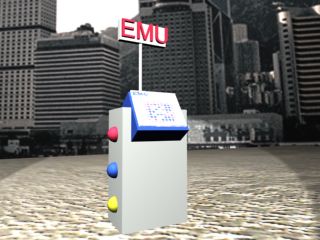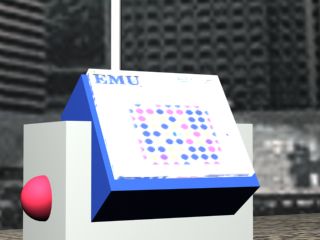 |
|
| EMU KIOSKS - Ubiquitous. Free and Easy to Use |

EMUWEBGRID Kiosk Proposal
"No network connection at all - zero bandwidth - makes you a digital hermit, an outcast from cyberspace. The Net creates new opportunities, but exclusion from it becomes a new form of marginalisation."
William J Mitchell, City of Bits, "Electronic Agoras" pp 18
EMU was conceived a purely public resource, one which would actually occupy public space in the form of SFNET style public terminals. These would enable the user to navigate EMU and the web sites it contains, as well as the links which those web sites made available via touch-screen interface. The aim of the EMU WEBGRID kiosk, is to provide internet connectivity in an easy to use way to those who otherwise would be totally excluded from participation.
 |
|
| EMU KIOSKS - Ubiquitous. Free and Easy to Use |

The kiosks would both serve those with EMU dots occupied, as well as those who did not have a site. A stranger could use a terminal to log onto the EMU grid. A limit would be set on how many sites a person could have, and redundant sites (those left unattended for 3 months or more) would automatically become available again.
| EMU KIOSKS operate like phone booths; free email, free localised information and free web sites for anyone who wants one, free of advertising, and the commercial imperative. |
Like any other free web hosting service, EMU would enable people to have a web presence, as well as free email, but unlike these services, would not be linked to advertising materials or commercial sponsorship of any kind. Rather EMU kiosks would be state or federally funded, in the same way as roads, parks, and other publicly shared urban facilities. The facility would be of particular benefit to the homeless, as it could act as a source of information about food, shelter and also act as a means of communication. For all who used the EMU kiosk, access to facilities could be made available in the context of the city itself, and with the increased availability of obsolete computers (e.g. a 486 computer can be bought for about A$80, an early pentium for $150), EMU kiosks could be installed wherever there was a line to connect it to the Internet.
Consider the obvious options. There is complete dissociation of the two (physical and virtual) if the electronic public space is accessible only from personal computers in homes and businesses. Another possibility is to associate access points with civic architecture: put an electronic information kiosk in the lobby of city hall or the public library for example. The Berkeley Community Memory and Santa Monica PEN system have demonstrated a more radical strategy by placing rugged workstations in places like laundromats and at congregation points for the homeless; these workstations thus begin to play a public role much like the traditional one of fountains in the public places like Rome.
William J Mitchell, City of Bits: Space, Place and the Infobahn, MIT, 1995, Soft Cities, pp 127
EMU WEB GRID PROVISIONAL COMMUNITY SERVICE VAN WITH MULTIPLE TERMINALS, JOYPADS AND/OR TOUCH SCREENS

A proposed van with EMU WEB GRID terminals with joy pads or touch screens which people can use for the duration of a day or a weekend or as long as is needed.
(picture is a Photoshop modified view of a Nintendo promotional trailer, advertising the Nintendo 64 Games platform, Brisbane, 2001)